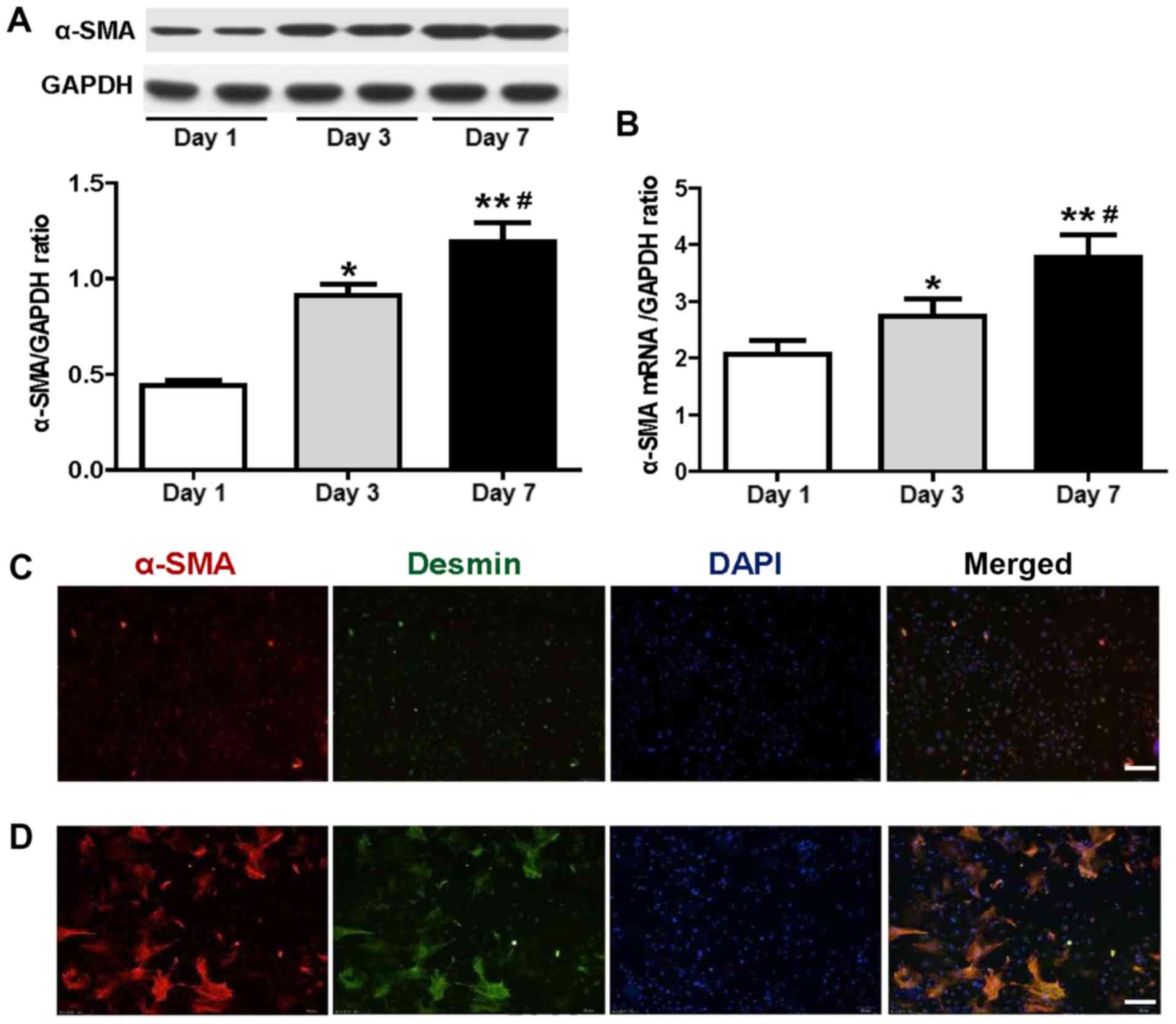|
1
|
Han X, Hong Y and Zhang K: TUG1 is
involved in liver fibrosis and activation of HSCs by regulating
miR-29b. Biochem Biophys Res Commun. 503:1394–1400. 2018.
View Article : Google Scholar : PubMed/NCBI
|
|
2
|
Friedman SL: Hepatic stellate cells:
Protean, multifunctional, and enigmatic cells of the liver. Physiol
Rev. 88:125–172. 2008. View Article : Google Scholar : PubMed/NCBI
|
|
3
|
Ding H, Ma JJ, Wang WP, Zeng WJ, Jiang T,
Huang BJ and Chen SY: Assessment of liver fibrosis: The
relationship between point shear wave elastography and quantitative
histological analysis. J Gastroenterol Hepatol. 30:553–558. 2015.
View Article : Google Scholar : PubMed/NCBI
|
|
4
|
Manon-Jensen T, Multhaupt HA and Couchman
JR: Mapping of matrix metalloproteinase cleavage sites on
syndecan-1 and syndecan-4 ectodomains. FEBS J. 280:2320–2331. 2013.
View Article : Google Scholar : PubMed/NCBI
|
|
5
|
Pasqualon T, Lue H, Groening S,
Pruessmeyer J, Jahr H, Denecke B, Bernhagen J and Ludwig A: Cell
surface syndecan-1 contributes to binding and function of
macrophage migration inhibitory factor (MIF) on epithelial tumor
cells. Biochim Biophys Acta. 1863:717–726. 2016. View Article : Google Scholar : PubMed/NCBI
|
|
6
|
Masola V, Gambaro G, Tibaldi E, Brunati
AM, Gastaldello A, D'Angelo A, Onisto M and Lupo A; Heparanase and
syndecan-1 interplay orchestrates fibroblast growth
factor-2-induced epithelial-mesenchymal transition in renal tubular
cells, : J Biol Chem. 287:1478–1488. 2012. View Article : Google Scholar : PubMed/NCBI
|
|
7
|
Yu Y, Duan J, Li Y, Li Y, Jing L, Yang M,
Wang J and Sun Z: Silica nanoparticles induce liver fibrosis via
TGF-beta1/Smad3 pathway in ICR mice. Int J Nanomedicine.
12:6045–6057. 2017. View Article : Google Scholar : PubMed/NCBI
|
|
8
|
Lee JH, Jang EJ, Seo HL, Ku SK, Lee JR,
Shin SS, Park SD, Kim SC and Kim YW: Sauchinone attenuates liver
fibrosis and hepatic stellate cell activation through TGF-beta/Smad
signaling pathway. Chem Biol Interact. 224:58–67. 2014. View Article : Google Scholar : PubMed/NCBI
|
|
9
|
Hara T, Yoshida E, Shinkai Y, Yamamoto C,
Fujiwara Y, Kumagai Y and Kaji T: Biglycan intensifies ALK5-Smad2/3
signaling by TGF-beta1 and downregulates syndecan-4 in cultured
vascular endothelial cells. J Cell Biochem. 118:1087–1096. 2017.
View Article : Google Scholar : PubMed/NCBI
|
|
10
|
Zhao H, Zhang LE, Guo S, Yuan T, Xia B,
Zhang L and Zhang Y: Overexpression of DNA methyltransferase 1 as a
negative independent prognostic factor in primary gastrointestinal
diffuse large B-cell lymphoma treated with CHOP-like regimen and
rituximab. Oncology Letters. 9:2307–2312. 2015. View Article : Google Scholar : PubMed/NCBI
|
|
11
|
Schuppan D and Afdhal NH: Liver cirrhosis.
Lancet. 371:838–851. 2008. View Article : Google Scholar : PubMed/NCBI
|
|
12
|
Schafer DF and Jones EA: Potential neural
mechanisms in the pathogenesis of hepatic encephalopathy. Prog
Liver Dis. 7:615–627. 1982.PubMed/NCBI
|
|
13
|
Takegami Y, Ohkawara B, Ito M, Masuda A,
Nakashima H, Ishiguro N and Ohno K: R-spondin 2 facilitates
differentiation of proliferating chondrocytes into hypertrophic
chondrocytes by enhancing Wnt/beta-catenin signaling in
endochondral ossification. Biochem Biophys Res Commun. 473:255–264.
2016. View Article : Google Scholar : PubMed/NCBI
|
|
14
|
Yang JJ, Tao H, Huang C and Li J: Nuclear
erythroid 2-related factor 2: A novel potential therapeutic target
for liver fibrosis. Food Chem Toxicol. 59:421–427. 2013. View Article : Google Scholar : PubMed/NCBI
|
|
15
|
Yang CQ, Yang L, Yang WZ, Zhang Z, Zhang
H, Chang YZ, Yuan M and Chen XM: Mechanism of hepatic stellate cell
migration during liver fibrosis. Zhonghua Yi Xue Za Zhi.
88:119–122. 2008.(In Chinese). PubMed/NCBI
|
|
16
|
Park SM, Deering RP, Lu Y, Tivnan P,
Lianoglou S, Al-Shahrour F, Ebert BL, Hacohen N, Leslie C, Daley
GQ, et al: Musashi-2 controls cell fate, lineage bias, and TGF-β
signaling in HSC. J Exp Med. 211:71–87. 2014. View Article : Google Scholar : PubMed/NCBI
|
|
17
|
Yu F, Fan X, Chen B, Dong P and Zheng J:
Activation of hepatic stellate cells is inhibited by
microRNA-378a-3p via wnt10a. Cell Physiol Biochem. 39:2409–2420.
2016. View Article : Google Scholar : PubMed/NCBI
|
|
18
|
Kim KA, Kakitani M, Zhao J, Oshima T, Tang
T, Binnerts M, Liu Y, Boyle B, Park E, Emtage P, et al: Mitogenic
influence of human R-spondin1 on the intestinal epithelium.
Science. 309:1256–1259. 2005. View Article : Google Scholar : PubMed/NCBI
|
|
19
|
Beauvais DM, Jung O, Yang Y, Sanderson RD
and Rapraeger AC: Syndecan-1 (CD138) suppresses apoptosis in
multiple myeloma by activating IGF1 receptor: Prevention by
synstatinIGF1R inhibits tumor growth. Cancer Res. 76:4981–4993.
2016. View Article : Google Scholar : PubMed/NCBI
|
|
20
|
Goto K: CD138 expression is observed in
the urothelial epithelium and in various urothelial carcinomas, and
cannot be evidence for plasmacytoid urothelial carcinoma. Int J
Surg Pathol. 24:614–619. 2016. View Article : Google Scholar : PubMed/NCBI
|
|
21
|
Xu D, Hu J, Xu S, De Bruyne E, Menu E, Van
Camp B, Vanderkerken K and Van Valckenborgh E: Dll1/Notch
activation accelerates multiple myeloma disease development by
promoting CD138+ MM-cell proliferation. Leukemia. 26:1402–1405.
2012. View Article : Google Scholar : PubMed/NCBI
|
|
22
|
Baghy K, Tátrai P, Regős E and Kovalszky
I: Proteoglycans in liver cancer. World J Gastroenterol.
22:379–393. 2016. View Article : Google Scholar : PubMed/NCBI
|
|
23
|
Regős E, Abdelfattah HH, Reszegi A, Szilák
L, Werling K, Szabó G, Kiss A, Schaff Z, Kovalszky I and Baghy K:
Syndecan-1 inhibits early stages of liver fibrogenesis by
interfering with TGFβ1 action and upregulating MMP14. Matrix Biol.
68-69:474–489. 2018. View Article : Google Scholar : PubMed/NCBI
|
















